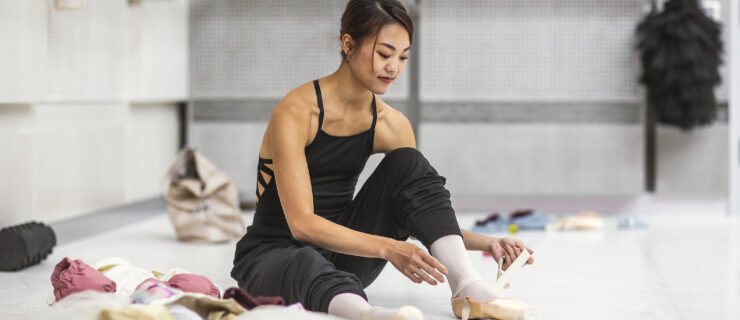Audition Success Stories
Looking for a job in a ballet company is likely the most daunting task of your career. It’s not enough to just hope you’ll get noticed at open auditions, or that your resumé will be plucked out of a pile of thousands. Landing that contract is rarely a straightforward process. Many directors now ask dancers to prove themselves through lengthy apprenticeships or project-based work. But while auditions are rough, they provide opportunities for self-examination and growth. Persistence, resourcefulness and patience are crucial on the bumpy road to employment as a ballet dancer.
Angelina Sansone was unprepared when The Joffrey Ballet let her go after a two-year apprenticeship. “I was devastated,” she says. “Joffrey had always been my dream.”
Audition season had already passed when she learned she wasn’t going to be promoted into the company. With no options, she enrolled at Indiana University. Her confidence was bruised, but she was determined to keep dancing professionally and traveled to as many open auditions as possible on weekends.
“From Indianapolis I drove to New York and Chicago,” she says, “sometimes driving through the night on Sundays for school on Monday. I knew I needed to show myself to everyone.”
The more auditions she attended, the more comfortable she became. “There were girls in black leotards and pink tights who’d stand in B-plus, eagerly nodding their heads,” says Sansone. “At first I thought that’s what directors wanted. But after a while I started to smile, or laugh if the teacher said something funny. I realized I had to be myself.”
She began donning a purple unitard, headscarf and a healthy dose of self-confidence. “I was determined to look like a professional, not a student,” she explains. Sansone also started researching companies that might be a good fit and saw a possibility with Kansas City Ballet. “The artistic director, Bill Whitener, had been a Joffrey dancer, so I thought I might have a leg up since I was familiar with where he came from.”
Whitener did notice her at the open audition, and he invited her to Kansas City to take class. When she arrived, “it just seemed right,” she says. “I knew I’d have something to contribute.”
Whitener sensed it, too, and offered her a contract. Sansone gladly accepted and is currently enjoying her fourth season in Kansas City.
Kirby Wallis, fresh out of Southern Methodist University in 2006, attended Ballet Austin’s open audition hoping for an apprenticeship. They were interested, but not yet ready to offer her a company position.
“They sent me a letter saying I was accepted to their school’s summer program with the possibility of an apprenticeship,” Wallis explains. Although she was nervous that her future was still uncertain, she took the gamble and enrolled.
“I wasn’t expecting it to be so hard,” she says. “There were 55 girls trying out for 3 spots!” Stephen Mills and Michelle Martin, Ballet Austin’s artistic and associate artistic directors, taught the classes and directed rehearsals. “It was very intense, and I was really stressed because this was my last option for the year.”
Luckily, Mills offered her a position at the end of the summer. The apprentices make up Ballet Austin II, which performs with the main company and on its own. The two-year program serves as an extended audition period.
“Mills and Martin were always testing us,” Wallis says, “giving us pieces of rep to see if we fit in.”
Towards the end of her second year, Wallis knew that company positions were scarce. She auditioned other places and had a possibility with Aspen Santa Fe Ballet. But in her heart she wanted to stay in Austin, so when Mills offered her a contract last spring, she was elated.
In retrospect, Wallis feels investing in the process of becoming a full company member was time well spent. “I feel prepared. I know Stephen’s likes and dislikes, and his movement style. And I could also assess whether Ballet Austin was right for me.”
Lindsay Purrington was already a seasoned professional when she found herself struggling to land a job. After being a soloist at Carolina Ballet, she spent a couple of years freelancing in New York. But she soon missed the stability of company life, and mailed her resumé, photographs and a 12-minute DVD to directors, hoping for an invitation to company class.
“I’m more relaxed taking company class because at least you know they’re interested enough to invite you there,” she says. She also attended several cattle calls, even though she felt they showed less of her full potential. “Sometimes I’d send a DVD to companies afterwards so they could get a sense of how I perform.”
She sent her audition materials to Pennsylvania Ballet in the summer of 2006. “I called two or three times after to see if they received it, but never heard back.”
That November, she learned they were looking for extra dancers for The Nutcracker and called again to express her
interest. She also asked Robert Weiss, her former artistic director at Carolina Ballet, and choreographer Lynne Taylor-Corbett, whom she had worked with extensively, to make recommendations. This time the company returned her call and invited her to take class.
Artistic Director Roy Kaiser observed, and a few days later, he offered her a six-week Nutcracker contract.
She jumped at the chance. “I knew Roy had hired guests into the company before,” she says, “so I wanted him to see me at my best. Each day felt like an audition.”
Purrington was able to show her professionalism in the studio as well as her performance skills. As luck would have it, a position opened up at the end of the run, and Kaiser offered it to her.
Purrington notes that persistence is a key element in being invited to a company class. “Don’t give up if a director doesn’t return your phone calls,” she says. “They’re not always in the office. And use whatever connections you have, whether it be a choreographer, former director or dancer. It can’t hurt.”
There are many different paths to success. Job-hunting can be a huge time investment between preparing resumé materials and traveling to auditions. But you shouldn’t rely on talent alone. Strategize, use connections and make repeat phone calls. And remain open-minded about what’s offered to you—you never know how an opportunity will present itself. “Don’t give up,” says Purrington. “Try anything you can to get a job. There are very few to go around!”
Amy Brandt is a dancer with The Suzanne Farrell Ballet.





